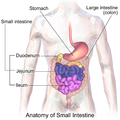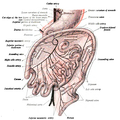Small intestine
The small intestine is between the stomach and the large intestine, and is where most of the digestion and absorption happen.[1] In humans over five years old, the small intestine is about 7.5 meters long. However, while it is long in length, it is short in diameter which is why it is dubbed the 'small intestine'.
The small intestine has three regions: the duodenum, the jejunum, and the ileum.
- The duodenum: receives bile and juice from the pancreas, and is where most digestion in the small intestine takes place. Secretions limit, or neutralise, the stomach acidity, and enzymes help to digest the food.
- The jejunum: the products of digestion (sugars, amino acids, and fatty acids) are absorbed into the bloodstream here.
- The ileum: absorbs vitamin B12, bile salts, and any other products of digestion that were not absorbed by the jejunum.
Small Intestine Media
Micrograph of the small intestine mucosa showing the intestinal villi and crypts of Lieberkühn.
Third state of the development of the intestinal canal and peritoneum, seen from in front (diagrammatic). The mode of preparation is the same as in Fig 400
Small intestine in situ, greater omentum folded upwards.








